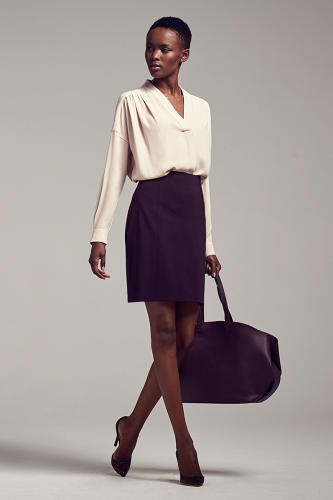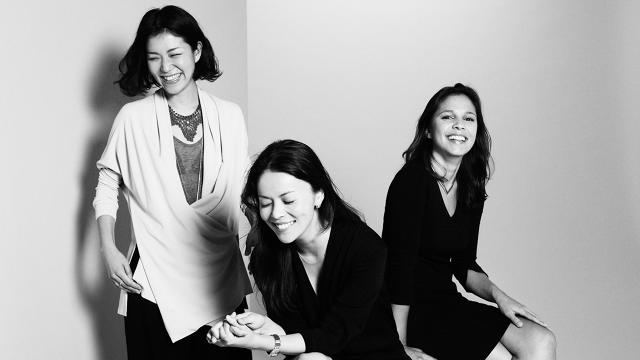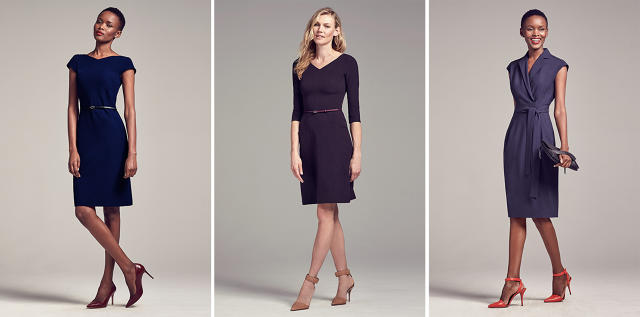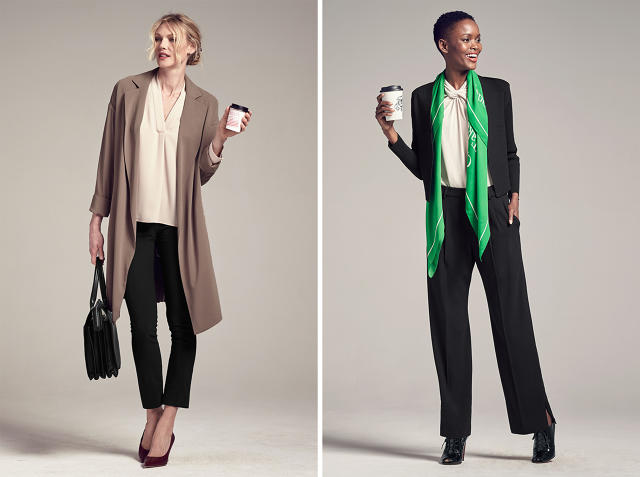
ELIZABETH SEGRAN 03.31.16 6:06 AM
“I’m so sick of the stereotype that all women are shopping-obsessed,” Sarah LaFleur, the 32-year-old cofounder of the workwear brand MM.LaFleur, tells Fast Company.
After college, LaFleur spent several years working in management consulting and private equity, where she needed a rotation of crisp, smart work clothes. But she had neither the time nor the inclination to shop for them. In her few free moments, the last thing she wanted to do was browse for blazers online or at a boutique. “For some women, buying clothes is just not a priority for one reason or another, but it doesn’t mean that they don’t care about good style or looking elegant,” she says.
LaFleur believed that there were many other female executives who felt like she did. So three years ago, she decided to do something radical. She started an online company called MM.LaFleur that challenged two deep-seated beliefs of the fashion industry: that women love the shopping experience, and want to buy trendy clothes.

MM.LaFleur founders: Miyako Nakamura, Sarah LaFleur, and Narie Foster
She partnered with Miyako Nakamura, the former head designer at Zac Posen, to create a line of classic shift dresses, pencil skirts, and blouses in muted colors that would appeal to working women of all ages. Together, they spent hours ensuring that each outfit was tailored to fit a wide range of women’s bodies. And with a third cofounder, Narie Foster, who headed up operations, they invented a system of selling these outfits to busy professional women without requiring them to spend any time shopping.
The idea seemed utterly ridiculous to investors. Who would spend $200 on a ludicrously basic shift dress or button-down shirt? And if a main selling point was the fit, why on earth would you sell them online instead of in a store, where women could try them on? “We had a very hard time fundraising,” LaFleur, who eventually found two institutional investors, explains. “Most of the male VCs we spoke with didn’t get what we were doing at all.”
But three years later, they’ve proved their naysayers wrong and convinced many, many women that they are providing a valuable service. One of MM.LaFleur’s basic dresses, a black wrap called the Tory, famously amassed a 1,600-person wait list last fall; the first pair of pants they ever designed sold out within two hours. Revenue grew nearly 600% in 2015 from a year earlier, and is projected to be $30 million in 2016. Over the last 12 months, its employee headcount has shot up from 14 to 70.

ENTER THE BENTO
MM.LaFleur’s solution to the “shopping problem” is to cut it out entirely, replacing it with what it calls a Bento Box. Inspired by the Japanese tradition of serving an entire five-course meal in a neat little box, MM.LaFleur sends customers a box of personally curated products from their website designed to come together as a complete set of outfits—dresses, blazers, even accessories—that a woman would need for a week at the office. Customers who visit the website are invited to answer a very short questionnaire about their style and body shape, and a week later the Bento arrives at their doorstep. They can keep and pay for the products they like, then return the rest for free.
“We actually know our clothes best,” LaFleur says. “If the customer shares a few details about herself, we think we can identify what will best work for her.”

Wear to Work
LaFleur’s philosophy is that women should have a professional “uniform,” much like the identical tailored suits that men wear to the office every day, because it will help them reduce the time it takes to choose an outfit in the morning. In the book Wear to Work that LaFleur cowrote with Tory Hoen, who edits the MM.LaFleur blog, LaFleur points out that Barack Obama only wears gray or blue suits to cut down on the number of decisions he has to make every day. The Bento is MM.LaFleur’s attempt to offer women a pre-selected uniform of work-appropriate, well-fitting outfits.
Unlike Stitch Fix or Trunk Club, the Bento Box is not a recurring personal styling subscription service. The goal of the box is to give the customer an opportunity to experience the quality and fit of the products without expecting her to spend time or effort in the shopping process. After a customer’s initial introduction to the brand through her first Bento, she can request further boxes to sample more products, or shop directly from the MM.LaFleur website.

MM.LaFleur’s Nisa dress, Alexandra dress, and Catherine dress
FIVE ITERATIONS OF THE SARAH DRESS
The Bento service allows women to experience the attention to detail that goes into every garment, since it is almost impossible to demonstrate this on a website, LaFleur says. “It’s so hard to know what works on your body by looking at a two-dimensional image,” she says. “We could have gone crazy trying to make the online experience like the offline experience, investing a ton of money on hundreds more images. But we went in the exact opposite direction: We don’t show the customer any outfits online before we send them to her, because we want her to see their subtle details in person.”
Those subtleties are a key part of Nakamura’s aesthetic, which is drawn from her Japanese heritage. “I take inspiration from the Japanese art of wrapping presents,” Nakamura says. “The wrapping technique is designed to highlight—not distract—from what is inside. I think the same should be true for clothes. A dress should enhance a woman’s body.”
To achieve a perfect fit, Nakamura uses a wide range of models during the design process, rather than just using a size two model and then proportionally scaling up, which is standard practice in the fashion industry. When she is creating a new dress, she drapes layers of material on the model, then cuts the dress as necessary to sculpt the right look and ensure that the fabric does not bunch up at the seams. The MM.LaFleur team also innovates by finding materials that look luxurious but are easy to maintain: Many of the clothes in the collection are machine washable and can be worn right out of the suitcase when a woman is on a business trip.
And unlike other brands that offer new clothes every season, MM.LaFleur does not respond to seasonal trends. Many of the dresses in their collection have been around since the company launched in 2013, which is not common among contemporary brands. The Sarah dress, for instance, was one of the first dresses Nakamura designed for MM.LaFleur three years ago, and it is still available. However, it is now called the Sarah 5.0 because it’s been tweaked five separate times based on customer feedback: One iteration changed the position of the darts, another removed pockets, yet another altered the bust.
“Most customers will never know all the ways we were thinking about these little nuances behind the scenes,” Nakamura says. “But they know how they feel when they wear the dress. As a designer, that’s where I feel satisfaction—knowing that I have been able to create that feeling.”

McCarren trench, and Evers Trouser
A PARTICULAR KIND OF WOMAN
MM.LaFleur’s approach isn’t for everyone. The brand is not going after women who are looking for the latest fashion trends or who are keen on wearing bright colors or bold prints to the office. It’s probably not going to get much traction among creatives who wear yoga pants to their coworking spaces. These looks are specifically catering to women in professions like law or consulting where standard business attire is the norm.
But the brand has demonstrated that there is a particular kind of woman who is looking to build an arsenal of simple, well-made work clothes with minimal effort. The majority of MM.LaFleur’s customers earn between $100,000 and $250,000 a year, and once they discover the brand, they tend to be very loyal. LaFleur says that nearly 40% of first-time customers place their second order within four weeks of their first. “A big part of our growth over the last three years has come from repeat customers,” she says.
While the brand is in the business of creating simple clothing, LaFleur believes that work clothes don’t have to be boring. They just shouldn’t take attention away from the things that women are doing in their careers. “Your clothes should be the least interesting thing about you,” LaFleur says. “From 8 a.m. to 8 p.m., working women are going about doing things that are important to them. As a brand, we’re saying that it is awesome being a professional woman in 2016. While there’s obviously still work that has to be done to break the glass ceiling, there are so many good things happening for us, and we want to celebrate that.”
[“source-Fastcompany.”]
| M | T | W | T | F | S | S |
|---|---|---|---|---|---|---|
| 1 | 2 | 3 | 4 | 5 | 6 | 7 |
| 8 | 9 | 10 | 11 | 12 | 13 | 14 |
| 15 | 16 | 17 | 18 | 19 | 20 | 21 |
| 22 | 23 | 24 | 25 | 26 | 27 | 28 |
| 29 | 30 | |||||
























